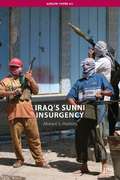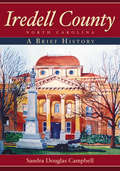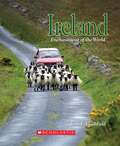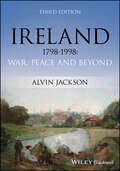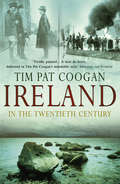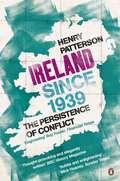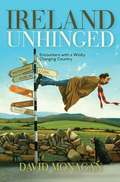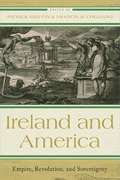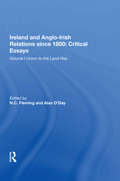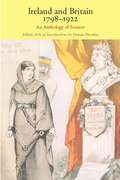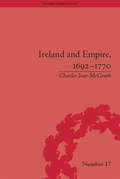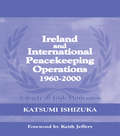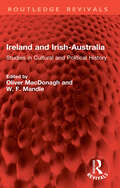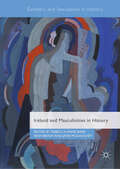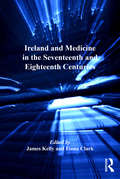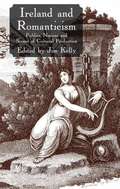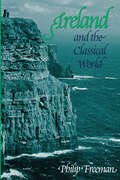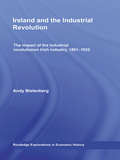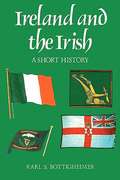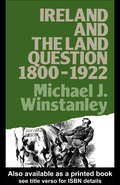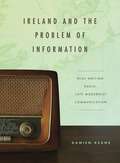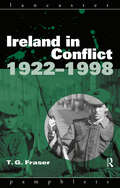- Table View
- List View
Iraq’s Sunni Insurgency: Iraq's Sunni Insurgency (Adelphi series)
by Ahmed S. HashimFrom 2003 to 2008, the Sunni Arab insurgency in Iraq posed a key challenge to political stability in the country and to Coalition objectives there. This paper explains the onset, composition and evolution of this insurgency. It begins by addressing both its immediate and deeper sociopolitical origins, and goes on to examine the multiple ideological strands within the insurgency and their often conflicting methods and goals. Despite organisational incoherence due to the existence of a large number of competing groups, the insurgency in Iraq sustained a particularly high tempo of operations between 2004 and 2006, causing considerable military and civilian casualties. Some insurgent groups focused on attempting to foment civil war between two of Iraq’s major communities, the Sunni and Shia Arabs and, by late 2006, they had come close to unravelling Iraq and presenting the Coalition with a major defeat. The adoption of a new approach by the US in 2007 helped reduce the level of violence in Iraq. In addition, deep fissures within the insurgency itself, between those fighting for more practical, immediate goals and the transnational Islamists and their local allies fighting for wider-reaching goals – including the promotion of sectarian strife – contributed to the insurgency’s diminution. It remains to be seen whether there will be a widespread recognition among Sunni Iraqis of the need to work with the Coalition to facilitate their community’s reintegration into the new Iraqi body politic.
Iredell County, North Carolina: A Brief History
by Sandra Douglas CampbellFrom the rough trails carved by the Catawba and the Cherokee to the "crossroads of the future," Iredell County has experienced a dramatic and poignant evolution, though its original innovative spirit and agricultural traditions persist to the present day. County native Sandra Douglas Campbell chronicles the area's rich history, drawing from its many renowned sites and from the extensive permanent collections of the Iredell Museums. Iredell County residents will welcome the volume's thorough treatment of their forebears' legacy, much of which can be seen and appreciated in their surroundings, and visitors to the county will appreciate the glimpse into an intriguing North Carolina history.
Ireland (Enchantment of the World #Second Series)
by Jean F. BlashfieldDescribes the history, geography, plant and animal life, economy, and culture of Ireland.
Ireland (Major European Union Nations)
by Ida WalkerNot long ago, Ireland was a country dealing with poverty and violence. Today, it has turned around and is now a peaceful nation. Ireland became a member of the EU in 1973. Its history also includes the Catholic Church, the potato famine, and long struggles for freedom. While Ireland's economy is currently doing poorly because of the global recession, it is working hard to recover. Discover more about this exciting, modern nation!
Ireland 1798-1998: War, Peace and Beyond
by Alvin JacksonThe new edition of Alvin Jackson’s highly influential survey of 200 years of Irish history In Ireland, 1798-1998: War, Peace, and Beyond, award-winning historian Alvin Jackson provides a well-balanced and authoritative account of modern Irish political history. Drawing on original research and extensive readings in current scholarship, the author surveys Irish political parties, leaders, and movements with a special emphasis on the tension between Irish nationalism and unionism. Opening with a wide-ranging introduction to Irish history, the text describes the varieties and interconnections of the Irish political experience through a sustained and coherent historical narrative, beginning with the creation of militant republicanism and militant loyalism in the 1790s. Reader-friendly chapters interweave social, economic, and cultural material while offering fresh analyses of familiar historical issues and personalities. This third edition contains expanded coverage of the most recent political developments in Ireland, both North and South. A new epilogue examines the impacts of the Good Friday Agreement, the global banking crisis, Brexit, and COVID-19 on Irish politics and institutions. The most up-to-date interpretation of modern Irish political history available in a single volume, Ireland, 1798-1998: War, Peace, and Beyond, Third Edition, is a must-read for undergraduate and graduate students working on Irish and British political history, as well as general readers with an interest in the subject.
Ireland In The 20th Century
by Tim Pat CooganIreland's bestselling popular historian tells the story of contemporary Ireland - controversial, authoritative and highly readable. Tim Pat Coogan's biographies of Michael Collins and DeValera and his studies of the IRA, the Troubles and the Irish Diaspora have transformed our understanding of contemporary Ireland, and all have been massive bestsellers. Now he has produced a major history of Ireland in the twentieth century. Covering both South and North and dealing with cultural and social history as well as political, this enthralling work will become the definitive single-volume account of the making of modern Ireland.
Ireland Since 1939
by Henry PattersonSynthesizing a vast body of scholarly work, Henry Patterson offers a compelling narrative of contemporary Ireland as a place poised between the divisiveness of deep-seated conflict and the modernizing - but perhaps no less divisive - pull of ever-greater material prosperity. Although the two states of Ireland have strikingly divergent histories, Patterson shows more clearly than any previous historian how interdependent those histories - and the mirroring ideologies that have fuelled them - have been. With its fresh and unpredictable readings of key events and developments on the island since the outbreak of the second world war, Ireland Since 1939 is an authoritative and gripping account from one of the most distinguished Irish historians at work today.
Ireland Unhinged: Encounters With a Wildly Changing Country
by David MonaganIreland Unhinged: Encounters with a Wildly Changing Country looks back at the changes that the economic boon wreaked on the Irish countryside and what the future holds for the country. Connecticut-born David Monagan explores his adopted country through the eyes of a passionate transplant. "What is Ireland? Has it lost its soul?" Monagan keeps asking as he roams from Cork to Dublin Donegal and Belfast. His answers are loving searing and often laugh-out-loud funny.
Ireland and America: Empire, Revolution, and Sovereignty (The Revolutionary Age)
by Gordon S. Wood T. H. Breen Annette Gordon-Reed Peter S. Onuf Francis D. Cogliano Christa Dierksheide Robert G. Ingram Trevor Burnard Nicholas Canny Jessica Choppin Roney S. Max Edelson Andrew J. O’Shaughnessy Matthew P. Dziennik Eliga Gould Rachel BankeLooking at America through the Irish prism and employing a comparative approach, leading and emerging scholars of early American and Atlantic history interrogate anew the relationship between imperial reform and revolution in Ireland and America, offering fascinating insights into the imperial whole of which both places were a part. Revolution would eventually stem from the ways the Irish and Americans looked to each other to make sense of imperial crisis wrought by reform, only to ultimately create two expanding empires in the nineteenth century in which the Irish would play critical roles.Contributors Rachel Banke, Illinois Mathematics and Science Academy * T. H. Breen, University of Vermont * Trevor Burnard, University of Hull * Nicholas Canny, National University of Ireland, Galway * Christa Dierksheide, University of Virginia * Matthew P. Dziennik, United States Naval Academy * S. Max Edelson, University of Virginia * Annette Gordon-Reed, Harvard University * Eliga Gould, University of New Hampshire * Robert G. Ingram, Ohio University * Peter S. Onuf, University of Virginia * Andrew J. O’Shaughnessy, International Center for Jefferson Studies at Monticello * Jessica Choppin Roney, Temple University * Gordon S. Wood, Brown University
Ireland and Anglo-Irish Relations since 1800: Volume I: Union to the Land War (Ireland And Anglo-irish Relations Since 1800: Critical Essays Ser.)
by N.C. FlemingThe Act of Union, coming into effect on 1 January 1801, portended the integration of Ireland into a unified, if not necessarily uniform, community. This volume treats the complexities, perspectives, methodologies and debates on the themes of the years between 1801 and 1879. Its focus is the making of the Union, the Catholic question, the age of Daniel O'Connell, the famine and its consequences, emigration and settlement in new lands, post-famine politics, religious awakenings, Fenianism, the rise of home rule politics and emergent feminism.
Ireland and Britain, 1798-1922: An Anthology of Sources
by Dennis DworkinThe clash between Britain and Ireland--and between Catholics and Protestants within Ireland--is among the oldest and most enduring nationalist, ethnic, and religious conflicts in the modern world, rooted in the colonization of Ireland by English and Scottish Protestants in the sixteenth and seventeenth centuries.Through fifty-six original sources, many of which have never been reprinted, this volume traces the origins and development of the conflict during the years of the legislative union between Britain and Ireland--years shaped by the rise of, and British and Irish Unionist responses to, Irish nationalism.Dworkin's Introduction provides both a history of the conflict and a discussion of its causes; headnotes and footnotes set each selection in historical, political, and cultural context, and identify those terms and names that may be unfamiliar to modern readers. A map, a glossary, a chronology of events, and a select bibliography are included, as are an index and several contemporary illustrations.
Ireland and Empire, 1692-1770 (Empires in Perspective #17)
by Charles Ivar McGrathHistorians often view early modern Ireland as a testing ground for subsequent British colonial adventures further afield. McGrath argues against this passive view, suggesting that Ireland played an enthusiastic role in the establishment and expansion of the first British Empire. He focuses on two key areas of empire-building: finance and defence.
Ireland and International Peacekeeping Operations 1960-2000
by Katsumi IshizukaThe Republic of Ireland has won its status as a leading contributor to international peacekeeping operations, which has been its key 'foreign policy' since the 1960s. But why is Ireland so keen to be involved? This new book asks and answers this and other key questions about Ireland's close involvement with the EU. It cannot simply be for charitable reasons, so is it because it is a neutral state or because it is a middle power? Overall, is Ireland's peacekeeping policy based on realism and liberalism? The characteristics of peacekeeping operations have changed significantly, especially since the end of the Cold War. Can Ireland survive as a traditional peacekeeping contributor or does it have to change its peacekeeping policy radically? And will it be able to maintain its distance from NATO and the EU in terms of peacekeeping operations? This title attempts to answer all of these questions, drawing on a wide range of resources from literature, Irish and UN documents, to newspapers and interviews.
Ireland and Irish-Australia: Studies in Cultural and Political History (Routledge Revivals)
by Oliver MacDonagh W. F. MandleThe Irish contribution to Australian history goes both deep and wide. Originally published in 1986 the essays in this collection contribute both to the understanding of Ireland’s place in Australian history and to the interpretation of the Irish scene in the nineteenth century. Ranging from law to W. B. Yeats, and from monumental sculpture to violence and crime, the papers reflect the diversity of the Irish-Australian experience and the persistence of a distinctively Irish culture even when transported across the world.
Ireland and Masculinities in History (Genders And Sexualities In History Ser.)
by Sean Brady Rebecca Anne Barr Jane McGaugheyThis edited collection presents a selection of essays on the history of Irish masculinities. Beginning with representations of masculinity in eighteenth-century drama, economics, and satire, and concluding with work on the politics of masculinity post Good-Friday Agreement in Northern Ireland, the collection advances the importance of masculinities in our understanding of Irish history and historiography. Using a variety of approaches, including literary and legal theory as well as cultural, political and local histories, this collection illuminates the differing forms, roles, and representations of Irish masculinities. Themes include the politicisation of Irishmen in both the Republic of Ireland and in Northern Ireland; muscular manliness in the Irish Diaspora; Orangewomen and political agency; the disruptive possibility of the rural bachelor; and aspirational constructions of boyhood. Several essays explore how masculinity is constructed and performed by women, thus emphasizing the necessity of differentiating masculinity from maleness. These essays demonstrate the value of gender and masculinities for historical research and the transformative potential of these concepts in how we envision Ireland’s past, present, and future.
Ireland and Medicine in the Seventeenth and Eighteenth Centuries (The History of Medicine in Context)
by James KellyThe story of early modern medicine, with its extremes of scientific brilliance and barbaric practice, has long held a fascination for scholars. The great discoveries of Harvey and Jenner sit incongruously with the persistence of Galenic theory, superstition and blood-letting. Yet despite continued research into the period as a whole, most work has focussed on the metropolitan centres of England, Scotland and France, ignoring the huge range of national and regional practice. This collection aims to go some way to rectifying this situation, providing an exploration of the changes and developments in medicine as practised in Ireland and by Irish physicians studying and working abroad during the seventeenth and eighteenth centuries. Bringing together research undertaken into the neglected area of Irish medical and social history across a variety of disciplines, including history of medicine, Colonial Latin American history, Irish, and French history, it builds upon ground-breaking work recently published by several of the contributors, thereby augmenting our understanding of the role of medicine within early modern Irish society and its broader scientific and intellectual networks. By addressing fundamental issues that reach beyond the medical institutions, the collection expands our understanding of Irish medicine and throws new light on medical practices and the broader cultural and social issues of early modern Ireland, Europe, and Latin America. Taking a variety of approaches and sources, ranging from the use of eplistolary exchange to the study of medical receipt books, legislative practice to belief in miracles, local professionalization to international networks, each essay offers a fascinating insight into a still largely neglected area. Furthermore, the collection argues for the importance of widening current research to consider the importance and impact of early Irish medical traditions, networks, and practices, and their interaction with related issues, such as politics, gender, economic demand, and religious belief.
Ireland and Romanticism
by Jim KellyThis collection by leading scholars in the field provides a fascinating and ground-breaking introduction to current research in Irish Romantic studies. It proves the international scope and aesthetic appeal of Irish writing in this period, and shows the importance of Ireland to wider currents in Romanticism.
Ireland and the Classical World
by Philip FreemanOn the boundary of what the ancient Greeks and Romans considered the habitable world, Ireland was a land of myth and mystery in classical times.<P><P> Classical authors frequently portrayed its people as savages—even as cannibals and devotees of incest—and evinced occasional uncertainty as to the island's shape, size, and actual location. Unlike neighboring Britain, Ireland never knew Roman occupation, yet literary and archaeological evidence prove that Iuverna was more than simply terra incognita in classical antiquity. <P> In this book, Philip Freeman explores the relations between ancient Ireland and the classical world through a comprehensive survey of all Greek and Latin literary sources that mention Ireland. He analyzes passages (given in both the original language and English) from over thirty authors, including Julius Caesar, Strabo, Tacitus, Ptolemy, and St. Jerome. To amplify the literary sources, he also briefly reviews the archaeological and linguistic evidence for contact between Ireland and the Mediterranean world. <P> Freeman's analysis of all these sources reveals that Ireland was known to the Greeks and Romans for hundreds of years and that Mediterranean goods and even travelers found their way to Ireland, while the Irish at least occasionally visited, traded, and raided in Roman lands. Everyone interested in ancient Irish history or Classics, whether scholar or enthusiast, will learn much from this pioneering book.
Ireland and the Industrial Revolution: The impact of the industrial revolution on Irish industry, 1801-1922 (Routledge Explorations in Economic History)
by Andy BielenbergThis monograph provides the first comprehensive analysis of industrial development in Ireland and its impact on Irish society between 1801-1922. Studies of Irish industrial history to date have been regionally focused or industry specific. The book addresses this problem by bringing together the economic and social dimensions of Irish industrial history during the Union between Ireland and Great Britain. In this period, British economic and political influences on Ireland were all pervasive, particularly in the industrial sphere as a consequence of the British industrial revolution. By making the Irish industrial story more relevant to a wider national and international audience and by adopting a more multi-disciplinary approach which challenges many of the received wisdoms derived from narrow regional or single industry studies - this book will be of interest to economic historians across the globe as well as all those interested in Irish history more generally.
Ireland and the Irish in Interwar England
by Mo MoultonTo what extent did the Irish disappear from English politics, life and consciousness following the Anglo-Irish War? Mo Moulton offers a new perspective on this question through an analysis of the process by which Ireland and the Irish were redefined in English culture as a feature of personal life and civil society rather than a political threat. Considering the Irish as the first postcolonial minority, she argues that the Irish case demonstrates an English solution to the larger problem of the collapse of multi-ethnic empires in the twentieth century. Drawing on an array of new archival evidence, Moulton discusses the many varieties of Irishness present in England during the 1920s and 1930s, including working-class republicans, relocated southern loyalists, and Irish enthusiasts. The Irish connection was sometimes repressed, but it was never truly forgotten; this book recovers it in settings as diverse as literary societies, sabotage campaigns, drinking clubs, and demonstrations.
Ireland and the Irish: A Short History
by Karl S. BottigheimerThis book tells the story of Ireland as well as it can be told, on the basis of up-to-date research, within the limits of three hundred pages.
Ireland and the Land Question 1800-1922 (Lancaster Pamphlets)
by Michael J. WinstanleyThis pamphlet makes use of the most recent revisionist literature to reassess the view, much propagated by nationalist sources, that Ireland was a land of impoverished peasants oppressed by English laws and absentee English landlords.The land question has always been closely linked to the development of Irish national consciousness, and greatly exercised the minds of English politicians in the latter part of the nineteenth century. The author examines the nature of English understanding of Irish problems, which was often limited or ignorant, and attributes to it much of the unsound and ineffective ligislation passed. The book is concerned less with questions of English party politics than with the situation in Ireland itself and with the nature of the English response to it.
Ireland and the Problem of Information: Irish Writing, Radio, Late Modernist Communication (Refiguring Modernism #20)
by Damien KeaneThough the work of Irish writers has been paramount in conventional accounts of literary modernism, Ireland itself only rarely occupies a meaningful position in accounts of modernism’s historical trajectory. With an itinerary moving not simply among Dublin, Belfast, and London but also Paris, New York, Addis Ababa, Rome, Berlin, Geneva, and the world’s radio receivers, Ireland and the Problem of Information examines the pivotal mediations through which social knowledge was produced in the mid-twentieth century. Organized as a series of cross-fading case studies, the book argues that an expanded sphere of Irish cultural production should be read as much for what it indicates about practices of intermedial circulation and their consequences as for what it reveals about Irish writing around the time of the Second World War. In this way, it positions the “problem of information” as, first and foremost, an international predicament, but one with particular national implications for the Irish field.
Ireland and the Problem of Information: Irish Writing, Radio, Late Modernist Communication (Refiguring Modernism)
by Damien KeaneThough the work of Irish writers has been paramount in conventional accounts of literary modernism, Ireland itself only rarely occupies a meaningful position in accounts of modernism’s historical trajectory. With an itinerary moving not simply among Dublin, Belfast, and London but also Paris, New York, Addis Ababa, Rome, Berlin, Geneva, and the world’s radio receivers, Ireland and the Problem of Information examines the pivotal mediations through which social knowledge was produced in the mid-twentieth century. Organized as a series of cross-fading case studies, the book argues that an expanded sphere of Irish cultural production should be read as much for what it indicates about practices of intermedial circulation and their consequences as for what it reveals about Irish writing around the time of the Second World War. In this way, it positions the “problem of information” as, first and foremost, an international predicament, but one with particular national implications for the Irish field.
Ireland in Conflict 1922-1998 (Lancaster Pamphlets)
by T. G. FraserIreland in Conflict, 1922-1998 sets out the main political, economic and social developments in Ireland, north and south of the border, since the 1922 treaty. This book explains the troubles in their context and examines the underlying tensions which led to prolonged violence after a period of relative civil peace and rising prosperity. Ireland in Conflict discusses: * the Civil War, its legacy for Irish politics and the Boundary Commission* the IRA, Orange Order and the Unionist party* the role of the Catholic Church and the Protestant minority* escalation of violence in the 1970s including Bloody Sunday and the hunger strikes* the Anglo-Irish agreement, the cease-fire and the hope for a peaceful solution.
